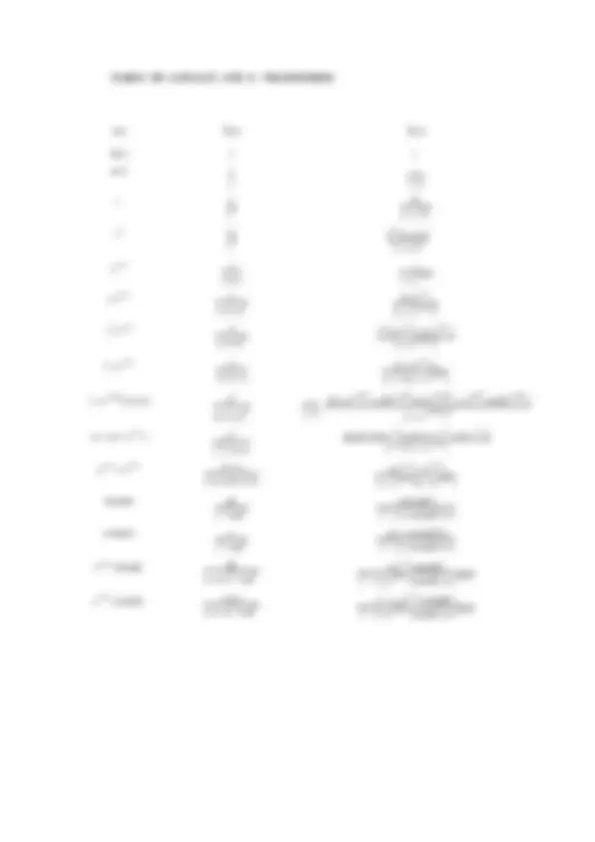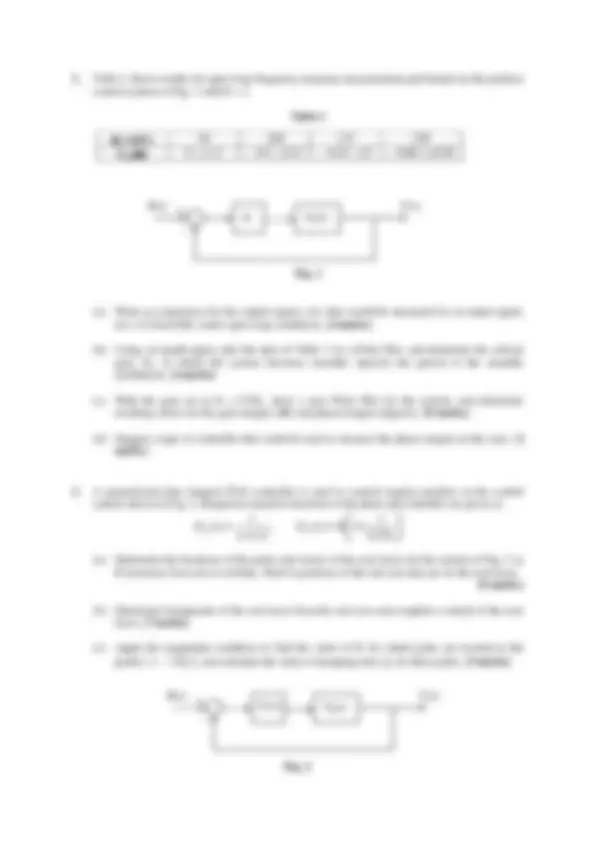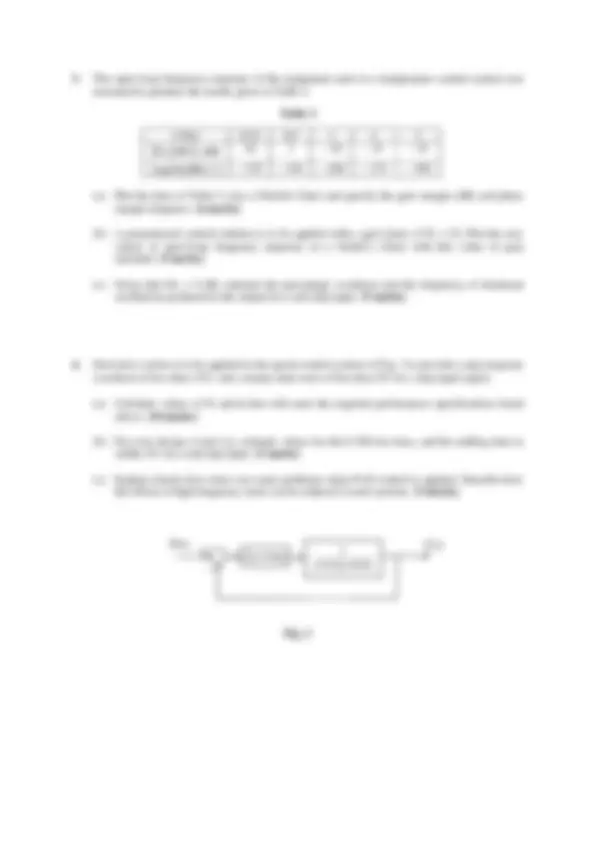Download Control System - Linear Control Systems I - Past Exam Paper and more Exams Linear Control Systems in PDF only on Docsity!
Spring Examinations 2008/ 2009
Exam Code(s) 3BN
Exam(s) Third Year Electronic Engineering
Module Code(s) EE
Module(s) Linear Control Systems
Paper No. 1
Repeat Paper
External Examiner(s) Prof. G. Irwin
Internal Examiner(s) Prof. G. Ó Laighin
Dr. M. Duffy
Instructions: Answer five questions from seven
All questions carry equal marks (20 marks)
Duration 3 hours
No. of Pages 7 (including cover)
Department(s) Electronic Engineering
Course Co-ordinator(s)
Requirements :
MCQ
Handout
Statistical Tables
Graph Paper Yes
Log Graph Paper Yes
Other Material Nichols Chart paper
The following standard formulas are given and may be freely used :
Mp Mo
(^) r (^) n 1 2 (^2) ( 0. 707)
(^) d (^) n 1 2
(^) b (^) n (1 2 2 ) (1 2 2 ) 1
Tr ( 0 95 %) 3 / (^) b ( 0. 4)
Tr (0 100%)
sin^1 1 2
(^) n 1 (^2) ( 1)
Overshoot 100 exp
Ts (2%)
(^) n
ln
^ ( 1)
Ts (5%)
(^) n
ln
^ ( 1)
Ziegler-Nichols Rules : Proportional : K = 0.5 Kc
P+I control : K = 0.45 Kc , Ti = 0.83 Tc
PID : K = 0.6 Kc , Ti = 0.5 Tc , Td = 0.125 Tc
1. Table 1 shows results for open-loop frequency response measurements performed on the position
control system of Fig. 1 with K = 1.
Table 1
(rad/s)^50 100 175
Gp(j ) 0 – j 1.2^ – 0.5 – j 0.5^ – 0.25 – j 0^ – 0.08 + j 0.
Fig. 1
(a) Write an expression for the output signal, c(t), that would be measured for an input signal,
r(t) = 0.5sin(100t), under open-loop conditions. [ 4 marks ]
(b) Using cm graph paper, plot the data of Table 1 on a Polar Plot, and determine the critical
gain, Kc, at which the system becomes unstable. Specify the period of the unstable
oscillations. [ 6 marks ]
(c) With the gain set at K = 0.5Kc, draw a new Polar Plot for the system, and determine
resulting values for the gain margin (dB) and phase margin (degrees). [ 8 marks ]
(d) Suggest a type of controller that could be used to increase the phase margin in this case. [ 2
marks ]
2. A proportional plus integral (P+I) controller is used to control angular position in the control
system shown in Fig. 2. Respective transfer functions of the plant and controller are given as:
(s 2 )
1 G (^) p (s)
, (^)
- 25 s
1 Gc(s) K 1
(a) Determine the locations of the poles and zeroes of the root locus for the system of Fig. 2 as
K increases from zero to infinity. Mark in portions of the real axis that are on the root locus.
[ 8 marks ]
(b) Determine breakpoints of the root locus from the real axis and complete a sketch of the root
locus. [ 7 marks ]
(c) Apply the magnitude condition to find the value of K for which poles are located at the
points s = – 2 j 2, and calculate the value of damping ratio, , for these poles. [ 5 marks ]
Fig. 2
_
R(s) C(s)
K^ Gp(s)
_
R(s) C(s)
Gc(s) Gp(s)
3. The open-loop frequency response of the equipment used in a temperature control system was
measured to produce the results given in Table 2.
Table 2
f (Hz) 0.25 0.5 1 2 3
G (j 2 f ) (dB) 16 1 – 10^ – 21^ – 32
Arg(G(j2f)) (o) – 125^ – 145^ – 160^ – 175^ – 190
(a) Plot the data of Table 2 onto a Nichols Chart and specify the gain margin (dB) and phase
margin (degrees). [ 6 marks ]
(b) A proportional control solution is to be applied with a gain factor of K = 2.8. Plot the new
values of open-loop frequency response on a Nichol’s Chart with this value of gain
included. [ 5 marks ]
(c) Given that Mo = 0 dB, estimate the percentage overshoot and the frequency of dominant
oscillations produced at the output for a unit step input. [ 9 marks ]
4. Derivative action is to be applied in the speed-control system of Fig. 3 to provide a step response
overshoot of less than 15%, and a steady-state error of less than 5% for a step input signal.
(a) Calculate values of K and that will meet the required performance specifications listed
above. [ 10 marks ]
(b) For your design of part (a), estimate values for the 0-100 rise time, and the settling time to
within 2% for a unit step input. [ 5 marks ]
(c) Explain clearly how noise can cause problems when P+D control is applied. Describe how
the effects of high frequency noise can be reduced in such systems. [ 5 marks ]
Fig. 3
_
R(s) C(s)
K( 1 s )
(s 1 )(s 10 )
7. Design specifications for a digital controller for a voltage regulator specify a step-response
overshoot of less than 20% and a 2% settling time of ~2 s.
(a) Assuming that the closed-loop behaviour may be approximated by that of a second-order
system, specify pole locations in the s-plane corresponding to the design specifications.
Suggest a suitable sampling interval, T, for the digital design. [ 9 marks ]
(b) An analogue controller with a transfer function,
s
s 3 Gc(s)
, is found to meet the
required design specifications. Using a sampling interval of T = 0.2 s, apply the bilinear
transformation method to derive the z-transfer function of a suitable digital controller. Write
the corresponding computer algorithm. [ 7 marks ]
(c) Explain why a component of phase-lead compensation is usually used in converting an
analogue controller solution to an equivalent digital controller design. [ 4 marks ]














